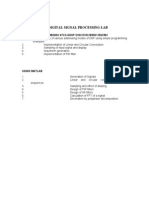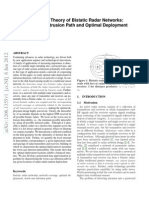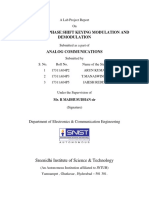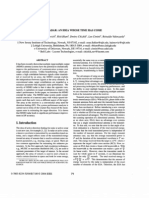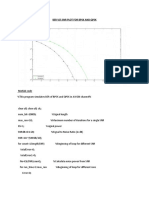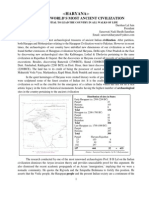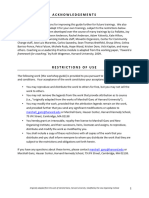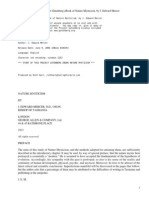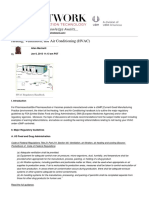Part-A Experiments Using Matlab: DSP Lab Manual
Part-A Experiments Using Matlab: DSP Lab Manual
Uploaded by
Sharth KumarCopyright:
Available Formats
Part-A Experiments Using Matlab: DSP Lab Manual
Part-A Experiments Using Matlab: DSP Lab Manual
Uploaded by
Sharth KumarOriginal Title
Copyright
Available Formats
Share this document
Did you find this document useful?
Is this content inappropriate?
Copyright:
Available Formats
Part-A Experiments Using Matlab: DSP Lab Manual
Part-A Experiments Using Matlab: DSP Lab Manual
Uploaded by
Sharth KumarCopyright:
Available Formats
DSP LAB MANUAL
2010
PART-A EXPERIMENTS USING MATLAB
1 RYMEC, BLY.
DSP LAB MANUAL
2010
% 01. Program to Sample a Band Limited continuous time signal, Band Limited to fm=100KHz % Under the following conditions: % (i) To Nyquist Rate % (ii) Twice the Nyquist Rate % (iii) Half the Nyquist Rate and Find the effect in each of the above.
t = 0 : 0.01 : 0.1; fm = input ('Enter the Input Signal Frequency (fm) : '); y = 2 * cos (2 * pi * fm * t); fs = input ('Enter the Sampling Frequency (fs) : '); ts = 1/fs; tx = 0 : ts : 0.1; ys = 2 * cos (2 * pi * fm * tx); subplot (2, 2, 1); stem (t, y); xlabel ('Time ---->'); ylabel ('Amplitude ---->'); title ('Input Signal'); subplot (2, 2, 2); stem (tx, ys); xlabel ('Time ---->'); ylabel ('Amplitude ---->'); title ('Signal Sampled at fs Hz'); x = abs (fft (y, 100)); k = 0 : length(y) - 1; subplot (2, 2, 3); stem (x); xlabel ('Time ---->'); ylabel ('Amplitude ---->'); title ('Spectrum of the Input Signal'); p = abs (fft (ys, 100)); k1 = 0 : length(ys) - 1; subplot (2, 2, 4) stem (p); xlabel ('Time ---->'); ylabel ('Amplitude ---->'); title ('Spectrum of the Sampled Signal');
2 RYMEC, BLY.
DSP LAB MANUAL
2010
RESULT: Case-1: fs < 2fm Enter the Input Signal Frequency (fm) : 20 Enter the Sampling Frequency (fs) : 20
Case-2: fs = 2fm Enter the Input Signal Frequency (fm) : 20 Enter the Sampling Frequency (fs) : 40
Case-3: fs > 2fm Enter the Input Signal Frequency (fm) : 20 Enter the Sampling Frequency (fs) : 80
3 RYMEC, BLY.
DSP LAB MANUAL
2010
% 02. Program to Find the Impulse Response of the Given System.
x = input ('Enter the Co-efficients of x : '); y = input ('Enter the Co-efficients of y : '); N = input ('Enter the Desired Impulse Response Length : '); n = 0 : 1 : N-1; d = ones (1, N); subplot (1, 2, 1) stem (n, d); [z, t] = impz (x, y, N); disp (z); disp (t); subplot (1, 2, 2) stem (t, z); xlabel ('Time ---->'); ylabel ('Magnitude ---->'); title ('Impulse Response');
4 RYMEC, BLY.
DSP LAB MANUAL
2010
RESULT:
5 RYMEC, BLY.
DSP LAB MANUAL
2010
% 03.Program to Find the linear convolution of two finite length sequences.
x=input('enter the value of x(n)='); h=input('enter the value of h(n)='); lx=length (x); lh=length(h); ly=lx+lh-1; y=conv(x,h); disp(x); disp(h); disp(y); n=0:1:lx-1; subplot(2,2,1) stem(n,x); xlabel('n---->'); ylabel('x(n)---->'); title('signal x(n)'); n=0:1:lh-1; subplot(2,2,2) stem(n,h); xlabel('n---->'); ylabel('x(n)---->'); title('signal h(n)'); n=0:1:ly-1; subplot(2,2,3) stem(n,y); xlabel('n---->'); ylabel('x(n)---->'); title('linear convolution');
6 RYMEC, BLY.
DSP LAB MANUAL
2010
RESULT:
7 RYMEC, BLY.
DSP LAB MANUAL
2010
% 04. Program to Find the Circular convolution of two finite length sequences.
Main Program: x1=input('Enter the first sequence: '); x2=input('Enter the second sequence: '); y1=conv(x1,x2) l1=length(x1); l2=length(x2); n1=max(l1,l2) y2=circonv(x1,x2,n1) n2=l1+l2-1 y3=circonv(x1,x2,n2) subplot(3,1,1) n1=0:1:length(y1)-1; stem(n1,y1); xlabel('time------>'); ylabel('amp------>'); title('linear convolution'); subplot(3,1,2) n2=0:1:length(y2)-1; stem(n2,y2); xlabel('time----->'); ylabel('amp----->'); title('circular convolution'); subplot(3,1,3) n3=0:1:length(y3)-1; stem(n3,y3); xlabel('time---->'); ylabel('amp----->'); title('linear conv by circular convolution'); Sub-Program: function[y] = circonv(x1, x2, N) l1=length(x1); l2=length(x2); X1 = [x1, zeros(1, N - l1)]; X2 = [x2, zeros(1, N - l2)]; H = zeros(N, N); for n = 1 : 1 : N m = n - 1; p = 0 : 1 : N - 1; q = mod(p - m, N); Xm = X2(q + 1); H(n,:) = Xm; end y = H' * X1';
8 RYMEC, BLY.
DSP LAB MANUAL
2010
RESULT:
9 RYMEC, BLY.
DSP LAB MANUAL
2010
%05. Program to find the Autocorrelation of a given sequence and verification of its properties.
%Autocorrelation: X=input('enter the sequence:'); Rxx=xcorr(X,X); figure(1) subplot(2,1,1) stem(X); xlabel('n---->'); ylabel('amplitude---->'); subplot(2,1,2) stem(fliplr(Rxx)) disp('Rxx'); fliplr(Rxx); % verification of its properties: x= input('enter the sequence'); l=length(x); x1=[x(l:-1:1)] rxx=conv(x,x1) %property 1:rxx"(0) gives the energy of the sequence centre = ceil(length(rxx)/2) n=-centre+1:1:centre-1 figure,stem(n,rxx) E=sum(x.^2) if(E==rxx(centre)) disp('rxx(0) value is equal to the energy of signal'); else disp('rxx(0) value is not equal to the energy of signal'); end % property 2:rxx(n)=rxx(-n) l1=length(rxx) zxx=[rxx(l1:-1:1)] if(zxx==rxx) disp('rxx(n) is equal to rxx(-n)'); else disp('rxx(n) is not equal to rxx(-n)'); end
10 RYMEC, BLY.
DSP LAB MANUAL
2010
RESULT:
11 RYMEC, BLY.
DSP LAB MANUAL
2010
%06. Program to find the Crosscorrelation of a given sequence and verification of its properties.
x=input('enter the first sequence'); y=input('enter the second sequence'); rxy=xcorr(x,y) l1=length(rxy) figure,stem(rxy); %property1:rxy(n)=ryx(-n) ryx=xcorr(y,x) l=length(ryx) zyx=[ryx(l:-1:1)] if (rxy==zyx) disp('rxy(n) is equal to rxy(-n)'); else disp('rxy(n) is not equal to rxy(-n)'); end %property2: ex=sum(x.^2) ey=sum(y.^2) rxx=xcorr(x,x); ryy=xcorr(y,y); c1=ceil(length(rxx)/2) c2=ceil(length(ryy)/2) if sqrt(ex*ey)==sqrt(rxx(c1)*ryy(c2)) disp('energy condition is satisfied'); else disp('energy condition is not satisfied'); end
12 RYMEC, BLY.
DSP LAB MANUAL
2010
RESULT:
13 RYMEC, BLY.
DSP LAB MANUAL
2010
%07. Program to solve a given Difference Equation.
a=input('Enter the Numerator Co-efficient a:'); b=input('Enter the Denominator Co-efficient b:'); [r,p,k]=residuez(a,b) [h,t]=impz(a,b,5) x= input('Enter the Input Sequence x(n):'); y=conv(x,h) subplot(2,1,1) stem(t,h) xlabel('Time->'); ylabel('Amplitude->'); title('Impulse response h(n)'); n=0:1:length(y)-1; subplot(2,1,2) stem(n,y) xlabel('Time->'); ylabel('Amplitude-'); title('Output Sequence y(n)');
14 RYMEC, BLY.
DSP LAB MANUAL
2010
RESULT:
15 RYMEC, BLY.
DSP LAB MANUAL
2010
%08. a) Program to compute N-point DFT of a given sequence and to plot magnitude and phase spectrum.
%Main Program: xn=input ('enter the input sequence:'); N=input('enter the values of N:'); Xk=dft(xn,N); k=0:1:N-1; subplot(2,1,1) stem(k,abs(Xk)); disp(Xk); xlabel('n---->'); ylabel('magnitude---->'); subplot(2,1,2) stem(k,angle(Xk)); xlabel('n---->'); %Sub Program: function[xk]=dft(xn,N) [N,m]=size(xn); if m ~=1 xn=xn'; N=m; end xk=zeros(N,1); n=0:N-1; for k=0:N-1 xk(k+1)=exp(-j*2*pi*k*n/N)*xn end
16 RYMEC, BLY.
DSP LAB MANUAL
2010
RESULT:
17 RYMEC, BLY.
DSP LAB MANUAL
2010
%08. b) Program to compute N-point IDFT of a given sequence and to plot magnitude and phase spectrum.
%Main Program: xk=input('enter the input sequence:'); N=input('enter the value of N:'); xn=idft(xk,N) n=0:1:N-1 subplot(2,1,1) stem(n,abs(xn)); disp(xn); xlabel('n---->'); ylabel('magnitude---->'); subplot(2,1,2) stem(n,angle(xn)); xlabel('n---->'); ylabel('phase spectrum---->'); %Sub Program: function[xn]=idft(Xk,N) [N,m]=size(Xk); if m~=1 Xk=Xk'; N=m; end xn=zeros(N,1); k=0:N-1 for n=0:N-1 xn(n+1)=1/N*exp(j*2*pi*k*n/N)*Xk; end
18 RYMEC, BLY.
DSP LAB MANUAL
2010
RESULT:
19 RYMEC, BLY.
DSP LAB MANUAL
2010
%09. a) Program to find the Linear Convolution of two sequences using DFT and IDFT.
%Main Program: xn1=input('Enter the First Sequence :'); xn2=input('Enter the Second Sequence :'); n1=length(xn1); n2=length(xn2); N=n1+n2-1; x1=[xn1,zeros(1,N-n1)]; x2=[xn2,zeros(1,N-n2)]; X1k=dft(x1,N) X2k=dft(x2,N) Zk=X1k.*X2k z=idft(Zk,N) subplot(3,1,1) N1=0:1:n1-1; stem(N1,xn1) xlabel('Time Index--->'); ylabel('Magnitude--->'); title('Sequence xn1'); subplot(3,1,2) N2=0:1:n2-1; stem(N2,xn2) xlabel('n--->'); ylabel('Magnitude--->'); title('Sequence xn2'); subplot(3,1,3) n=0:1:N-1; stem(n,z) xlabel('n--->'); ylabel('Magnitude--->'); title('Linear Convolution'); %Sub Program for DFT: function[xk]=dft(xn,N) [N,m]=size(xn); if m~=1 xn=xn'; N=m; end xk=zeros(N,1); n=0:N-1; for k=0:N-1 xk(k+1)=exp(-j*2*pi*k*n/N)*xn end %Sub Program for IDFT: function[xn]=idft(Xk,N) [N,m]=size(Xk); if m~=1 Xk=Xk'; N=m; end xn=zeros(N,1); k=0:N-1 for n=0:N-1 xn(n+1)=1/N*exp(j*2*pi*k*n/N)*Xk; end
20 RYMEC, BLY.
DSP LAB MANUAL
2010
RESULT:
21 RYMEC, BLY.
DSP LAB MANUAL
2010
%09. b) Program to find the Linear Convolution of two sequences using FFT and IFFT.
xn1=input('Enter the First Sequence xn1:'); xn2=input('Enter the Second Sequence xn2:'); n1=length(xn1); n2=length(xn2); N=n1+n2-1; x1=[xn1,zeros(1,N-n1)]; x2=[xn2,zeros(1,N-n2)]; X1k=fft(x1,N) X2k=fft(x2,N) Zk=X1k.*X2k z=ifft(Zk,N) subplot(3,1,1) N1=0:1:n1-1; stem(N1,xn1) xlabel('Time Index--->'); ylabel('Magnitude--->'); title('Sequence xn1'); subplot(3,1,2) N2=0:1:n2-1; stem(N2,xn2) xlabel('n--->'); ylabel('Magnitude--->'); title('Sequence xn2'); subplot(3,1,3) n=0:1:N-1; stem(n,z) xlabel('n--->'); ylabel('Magnitude--->'); title('Linear Convolution');
22 RYMEC, BLY.
DSP LAB MANUAL
2010
RESULT:
23 RYMEC, BLY.
DSP LAB MANUAL
2010
%10. a) Program to find the Circular Convolution of two sequences using DFT and IDFT.
%Main Program: x1=input('enter the first sequence:'); x2=input ('enter the second sequence:'); N=input('enter the valus of n:'); x=dft(x1,N); y=dft(x2,N); z=x.*y; p=idft(z,N); n=0:1:N-1; subplot(2,2,1) stem(n,x1); disp(x1); xlabel('n---->'); ylabel('x1(n)---->'); title('input signal x1(n)---->'); n=0:1:N-1; subplot(2,2,2) stem(n,x2); disp(x2); xlabel('n---->'); ylabel('x2(n)---->'); title('signalx2(n)'); n=0:1:N-1; subplot(2,2,3) stem(n,p); disp(p); xlabel('n---->'); ylabel('p---->'); title('circular convolution'); %Sub Program for DFT: function[xk]=dft(xn,N) [N,m]=size(xn); if m~=1 xn=xn'; N=m; end xk=zeros(N,1); n=0:N-1; for k=0:N-1 xk(k+1)=exp(-j*2*pi*k*n/N)*xn end %Sub Program for IDFT: function[xn]=idft(Xk,N) [N,m]=size(Xk); if m~=1 Xk=Xk'; N=m; end xn=zeros(N,1); k=0:N-1 for n=0:N-1 xn(n+1)=1/N*exp(j*2*pi*k*n/N)*Xk; end
24 RYMEC, BLY.
DSP LAB MANUAL
2010
RESULT:
25 RYMEC, BLY.
DSP LAB MANUAL
2010
%10. b) Program to find the Circular Convolution of two sequences using FFT and IFFT.
x1=input('enter the first sequence:'); x2=input ('enter the second sequence:'); N=input('enter the valus of n:'); x=fft(x1,N); y=fft(x2,N); z=x.*y; p=ifft(z,N); n=0:1:N-1; subplot(2,2,1) stem(n,x1); disp(x1); xlabel('n---->'); ylabel('x1(n)---->'); title('input signal x1(n)---->'); n=0:1:N-1; subplot(2,2,2) stem(n,x2); disp(x2); xlabel('n---->'); ylabel('x2(n)---->'); title('signalx2(n)'); n=0:1:N-1; subplot(2,2,3) stem(n,p); disp(p); xlabel('n---->'); ylabel('p---->'); title('circular convolution');
26 RYMEC, BLY.
DSP LAB MANUAL
2010
RESULT:
27 RYMEC, BLY.
DSP LAB MANUAL
2010
%11. Program to design and implement an FIR filter to meet given specifications. %Pass Band Ripple : .25 %Stop Band Ripple : 50 %Pass Band cut off Frequency : .2*pi %Stop Band cut off Frequency : .25*pi %Cut off Frequence : .2
ap=input('enter the pass band ripple:') as=input('enter the stop band ripple:') wp=input('enter the pass band cut off frequency:') ws=input('enter the stop band cut off frequency:') wc=input('enter the cut off frequency:') t=(ws-wp)/(2*pi) n=8*pi/(ws-wp) wh=hamming(n); b=fir1(n-1,wc); w=0:0.01:pi; h=freqz(b,1,w); m=20*log10(abs(h)) plot(w,m) xlabel('frequency---->') ylabel('magnitude---->') title('response of fir low pass filter')
28 RYMEC, BLY.
DSP LAB MANUAL
2010
RESULT: enter the pass band ripple:0.25 ap = 0.2500 enter the stop band ripple:50 as = 50 enter the pass band cut off frequency:0.2*pi wp = 0.6283 enter the stop band cut off frequency:0.3*pi ws = 0.9425 enter the cut off frequency:0.2 wc = 0.2000 t= 0.0500 n= 80
29 RYMEC, BLY.
DSP LAB MANUAL
2010
%12. a) Program to design and implement an IIR filter to meet given specifications. % Pass Band Attenuation : .5 %Stop Band Attenuation : 15 %Pass Band Edge Frequency : .25*pi %Stop Band Edge Frequency : .55*pi %Sampling Frequency : 1 ap=input('enter pass band attenuation:') as=input('enter stop band attenuation:') wp=input('enter pass band edge frequency:') ws=input('enter stop band edge frequency:') t=input('enter sampling frequency:') fs=1/t; %translation of analog to digital wp=wp/fs ws=ws/fs %pre-wrapping wpp=(2/t)*tan(wp/2) wss=(2/t)*tan(ws/2) %to obtain H(s) [N,wc]=cheb1ord(wpp,wss,ap,as,'s') [a,b]=cheby1(N,ap,wc,'s') %analog to digital transformation [az,bz]=bilinear(a,b,fs) %plot of response k=0:0.01/pi:pi; h=freqz(az,bz,k); gain=20*log10(abs(h)); subplot(3,1,1) plot(k,abs(h)); subplot(3,1,2) plot(k,gain); grid on; subplot(3,1,3) plot(k,angle(h));
30 RYMEC, BLY.
DSP LAB MANUAL
2010
RESULT: enter pass band edge frequency:0.2*pi wp =0.6283 enter stop band edge frequency:0.3*pi ws = 0.9425 enter pass band attenuation:1 ap = 1 enter stop band attenuation:15 as = 15 enter sampling frequency:1 t= 1 wp = 0.6283 ws = 0.9425 wpp = 0.6498 wss = 1.0191 N= 4 wc = 0.6498 a= Columns 1 through 3 0 0 0 Columns 4 through 5 0 0.0438 b= Columns 1 through 3 1.0000 0.6192 0.6140 Columns 4 through 5 0.2038 0.0492 az = Columns 1 through 3 0.0018 0.0073 0.0110 Columns 4 through 5 0.0073 0.0018 bz = Columns 1 through 3 1.0000 -3.0543 3.8290 Columns 4 through 5 -2.2925 0.5507
31 RYMEC, BLY.
DSP LAB MANUAL
2010
%12. b) Program to design an butterwirth iir filter to meet given specifications. %Pass band attenuation:1 %Stop band attenuation:15 %Pass band frequency:.25*pi %Stop band frequency :.55*pi %Sampling frequency :1
ap=input('enter the pass band attenuation:'); as=input('enter the stop band attenuation:'); fp=input('enter the pass band frequency:'); fs=input('enter the stop band frequency :'); Fs=input('enter the sampling frequency :'); w1=fp*Fs; w2=fs*Fs; [N,wn]=buttord(w1,w2,ap,as,'s') [b,a]=butter(N,wn,'s') [Num,Den]=impinvar(b,a,Fs) freqz(Num,Den) title('butter worth low pass filter frequency response');
32 RYMEC, BLY.
DSP LAB MANUAL
2010
RESULT: enter the pass band attenuation:1 enter the stop band attenuation:15 enter the pass band frequency:.25*pi enter the stop band frequency :.55*pi enter the sampling frequency :1 N= 4 wn = 1.1266 b= Columns 1 through 4 0 0 0 0 Column 5 1.6107 a= Columns 1 through 4 1.0000 2.9439 4.3332 3.7362 Column 5 1.6107 Num = Columns 1 through 4 -0.0000 0.1212 0.2211 0.0281 Column 5 0 Den = Columns 1 through 4 1.0000 -1.2987 0.9685 -0.3529 Column 5 0.0527
33 RYMEC, BLY.
DSP LAB MANUAL
2010
PART-B EXPERIMENTS USING DSP PROCESSOR
34 RYMEC, BLY.
DSP LAB MANUAL
2010
1. Program to Find the Linear convolution of two finite length sequences. #include<stdio.h> int y[20]; main() { int m=6; int n=6; int i=0,j; int x[15]={1,2,3,4,5,6,0,0,0,0,0,0}; int h[15]={1,2,3,4,5,6,0,0,0,0,0,0}; for(i=0;i<m+n-1;i++) { y[i]=0; for(j=0;j<=i;j++) y[i]+=x[j]*h[i-j]; /*Length of i/p samples sequence*/ /*Length of impulse response Co-efficients */ /*Input Signal Samples*/ /*Impulse Response Co-efficients*/
for(i=0;i<m+n-1;i++) printf("%d\n",y[i]); }
RESULT:
35 RYMEC, BLY.
DSP LAB MANUAL
2010
2. Program to Find the Circular convolution of two finite length sequences. #include<stdio.h> #include<math.h> int m,n,x[30],h[30],y[30],i,j,temp[30],k,x2[30],a[30]; void main() { printf("enter the length of 1st sequence\n"); scanf("%d",&m); printf("enter the length of 2nd sequence\n"); scanf("%d",&n); printf("enter the 1st sequence\n"); for(i=0;i<n;i++) scanf("%d",&x[i]); printf("enter the 2nd sequence\n"); for(j=0;j<n;j++) scanf("%d",&h[j]); if(m-n!=0) { if(m>n) {
} for(i=m;i<n;i++) h[i]=0; m=n;
for(i=n;i<m;i++) x[i]=0; n=m;
y[0]=0; a[0]=h[0]; for(j=1;j<n;j++) a[j]=h[n-j]; for(i=0;i<n;i++) y[0]+=x[i]*a[i];
36 RYMEC, BLY.
DSP LAB MANUAL
2010
for(k=1;k<n;k++) { y[k]=0; for(j=1;j<n;j++) x2[j]=a[j-1]; x2[0]=a[n-1]; for(i=0;i<n;i++) { a[i]=x2[i]; y[k]+=x[i]*x2[i]; } } printf("\n circular convolution\n"); for(i=0;i<n;i++) printf("%d\t",y[i]); }
37 RYMEC, BLY.
DSP LAB MANUAL
2010
RESULT:
38 RYMEC, BLY.
DSP LAB MANUAL
2010
3. Program to Find the Impulse response of first order and second order system. #include<stdio.h> #define order 2 #define len 7 float Y[len]={0,0,0},sum; void main() { int j,k; float a[order+1]={1,3}; float b[order+1]={1,2,3}; for(j=0;j<len;j++) { sum=0; for(k=1;k<=order;k++) { if(j-k>=0) sum+=b[k]*Y[j-k]; } if(j<=order) { Y[j]=a[j]-sum; } else Y[j]=-sum; printf("response[%d]%f\n\n",j,Y[j]); } }
39 RYMEC, BLY.
DSP LAB MANUAL
2010
RESULT:
40 RYMEC, BLY.
You might also like
- Lab ManualDocument49 pagesLab ManualDeepika PalrajNo ratings yet
- Optimum Array Processing: Part IV of Detection, Estimation, and Modulation TheoryFrom EverandOptimum Array Processing: Part IV of Detection, Estimation, and Modulation TheoryNo ratings yet
- DSP LAB 1to 6Document12 pagesDSP LAB 1to 6daddyplays25No ratings yet
- DSP Lab Manual 19 Nov 20111Document35 pagesDSP Lab Manual 19 Nov 20111TapasRoutNo ratings yet
- DSP Lab Manual AlignDocument134 pagesDSP Lab Manual AlignSilent Trigger GamingNo ratings yet
- MatlabDocument34 pagesMatlabMeghanaNo ratings yet
- Digital Signal Processing Lab: Practical RecordDocument30 pagesDigital Signal Processing Lab: Practical RecordAnveshGopalamNo ratings yet
- Experiments Using MatlabDocument8 pagesExperiments Using MatlabAnanyaNairNo ratings yet
- Lab Report 4 DSPDocument8 pagesLab Report 4 DSPKhansa MaryamNo ratings yet
- ELE302 - Lab 2-092021Document17 pagesELE302 - Lab 2-092021hughjass39.99No ratings yet
- DMEDocument52 pagesDMEhavaciNo ratings yet
- Quad - Channel - Software - Defined - Receiver For Passive RadarDocument12 pagesQuad - Channel - Software - Defined - Receiver For Passive RadarPraphul ChandraNo ratings yet
- EITN90 Radar and Remote Sensing Lecture 4: Characteristics of ClutterDocument56 pagesEITN90 Radar and Remote Sensing Lecture 4: Characteristics of Cluttertdtiog hohdedkkNo ratings yet
- Radar 1Document67 pagesRadar 1mancangkulNo ratings yet
- (1967) Digital Pulse Compression Radar ReceiverDocument9 pages(1967) Digital Pulse Compression Radar ReceiverAlex YangNo ratings yet
- Quadrifilar Helix Antenna For Small Satellites: Abstract: in This Paper, We Discuss TheDocument5 pagesQuadrifilar Helix Antenna For Small Satellites: Abstract: in This Paper, We Discuss TheCesar castañedaNo ratings yet
- Radar Principles: Technical ReportDocument8 pagesRadar Principles: Technical ReportRuby YadavNo ratings yet
- Instrumentation and Measurement: Laboratory ManualDocument6 pagesInstrumentation and Measurement: Laboratory ManualFakharNo ratings yet
- Antennas PDFDocument2 pagesAntennas PDFwaytelaNo ratings yet
- Exact Analysis of DDS Spurs and SNR Due To Phase Truncation and Arbitrary Phase-To-Amplitude ErrorsDocument9 pagesExact Analysis of DDS Spurs and SNR Due To Phase Truncation and Arbitrary Phase-To-Amplitude Errorsclurado1980No ratings yet
- Designing A Basic Mono Static Pulse Radar DemoDocument10 pagesDesigning A Basic Mono Static Pulse Radar Demoaqua_salmanNo ratings yet
- 2100 New IlsDocument112 pages2100 New IlsSquish DrawsNo ratings yet
- FMCW Radar Is A Special Type of Radar Sensor Which Radiates: Frequency-Modulated Continuous-Wave RadarDocument8 pagesFMCW Radar Is A Special Type of Radar Sensor Which Radiates: Frequency-Modulated Continuous-Wave RadarSummer KoNo ratings yet
- Power Spectral Density MatlabDocument3 pagesPower Spectral Density MatlabAnand Raj100% (2)
- Analog Communication Lab Final Doc SRN PDFDocument90 pagesAnalog Communication Lab Final Doc SRN PDFChaitanya ReddyNo ratings yet
- VOR Part2 TextDocument178 pagesVOR Part2 Textcmge_2005No ratings yet
- Bistatic RadarDocument12 pagesBistatic RadarHameed HamedNo ratings yet
- Secure Authentication Protocol For 5G Enabled Iot NetworkDocument6 pagesSecure Authentication Protocol For 5G Enabled Iot NetworkOsama AdlyNo ratings yet
- QPSK Mod&Demodwith NoiseDocument32 pagesQPSK Mod&Demodwith Noisemanaswini thogaruNo ratings yet
- Advanced Communication Lab Manual PDFDocument61 pagesAdvanced Communication Lab Manual PDFRachel BartonNo ratings yet
- Mimo CodeDocument3 pagesMimo CodeEstifanos LisaneworkNo ratings yet
- MATHESH Matlab Final OutputDocument19 pagesMATHESH Matlab Final OutputSivabalan MNo ratings yet
- Doa WhitepaperDocument14 pagesDoa WhitepaperUfuk TamerNo ratings yet
- Application of High Resolution Direction Finding Algorithms in Mobile CommunicationsDocument6 pagesApplication of High Resolution Direction Finding Algorithms in Mobile CommunicationsLamiae SqualiNo ratings yet
- Mobile Radio Propagation Small-Scale Fading and MultipathDocument63 pagesMobile Radio Propagation Small-Scale Fading and MultipathRutuja VartaleNo ratings yet
- FMCW PrincipeDocument21 pagesFMCW PrincipeTom GNo ratings yet
- Radio Wave PropagationDocument81 pagesRadio Wave PropagationJoseph JeremyNo ratings yet
- Matlab QuestionsDocument9 pagesMatlab QuestionsNimal_V_Anil_2526100% (2)
- Digital Signal Processing Lab ManualDocument171 pagesDigital Signal Processing Lab ManualRaj Kumar ChowdaryNo ratings yet
- Radio Propagation Theory and Models ISSUE1.0Document39 pagesRadio Propagation Theory and Models ISSUE1.0Subhi RosdianNo ratings yet
- MWL05 ManualDocument81 pagesMWL05 ManualMustafa SeçmenNo ratings yet
- DSP Lab ManualDocument54 pagesDSP Lab Manualkpsvenu100% (1)
- Range Resolution and Unambiguous Range: Dr.V.R.S. MANI Associate Professor (SG) / ECE NECDocument15 pagesRange Resolution and Unambiguous Range: Dr.V.R.S. MANI Associate Professor (SG) / ECE NECMani VrsNo ratings yet
- AppendixDocument19 pagesAppendixDr-Eng Imad A. ShaheenNo ratings yet
- Mat Lab Program For F SK Transmitter and ReceiverDocument3 pagesMat Lab Program For F SK Transmitter and Receiverben tenNo ratings yet
- 322 - EC8395 Communication Engineering - Notes PDFDocument124 pages322 - EC8395 Communication Engineering - Notes PDFAjitNo ratings yet
- 725 Intro-F12Document98 pages725 Intro-F12Mahaboob SubahanNo ratings yet
- MARU 220 Manual Vol 1 PDFDocument180 pagesMARU 220 Manual Vol 1 PDFSasongko FightNo ratings yet
- MIMO Radar A Idea Whose Time Has ComeDocument8 pagesMIMO Radar A Idea Whose Time Has Cometrongnguyen29No ratings yet
- Ber V/S SNR Plot For BPSK and QPSKDocument3 pagesBer V/S SNR Plot For BPSK and QPSKabhijeetsahu21119907617No ratings yet
- Performance Comparison NOMA - OFDMDocument3 pagesPerformance Comparison NOMA - OFDMfekadu100% (1)
- Microwave Filters for Communication Systems: Fundamentals, Design, and ApplicationsFrom EverandMicrowave Filters for Communication Systems: Fundamentals, Design, and ApplicationsNo ratings yet
- The SatNav Users Guide to Navigation and Mapping Using GPSFrom EverandThe SatNav Users Guide to Navigation and Mapping Using GPSRating: 1 out of 5 stars1/5 (2)
- Bharathidasan Engineering College: Department of Electronics & Communication EngineeringDocument71 pagesBharathidasan Engineering College: Department of Electronics & Communication EngineeringnarasimhanNo ratings yet
- DSP Lab ManualDocument20 pagesDSP Lab ManualRavi RavikiranNo ratings yet
- DSP 72Document42 pagesDSP 72SakethNo ratings yet
- Matlab Programs ManualDocument18 pagesMatlab Programs Manualsudharsan100% (1)
- Css3 AnimationDocument3 pagesCss3 AnimationSharth KumarNo ratings yet
- Op v3 PreviewDocument59 pagesOp v3 PreviewSharth KumarNo ratings yet
- India-Bangladesh Relations - Rimpa DuttaDocument11 pagesIndia-Bangladesh Relations - Rimpa DuttaPraveen Kumar ThotaNo ratings yet
- Gess 201..,useful For Ias PreperationDocument6 pagesGess 201..,useful For Ias PreperationSharth KumarNo ratings yet
- Power Mosfets: Introduction To Fet'SDocument21 pagesPower Mosfets: Introduction To Fet'SSharth KumarNo ratings yet
- HARYANA - Cradle of World's Most Ancient CivilisationDocument6 pagesHARYANA - Cradle of World's Most Ancient CivilisationquigiNo ratings yet
- Disc SalesDocument46 pagesDisc SalesValaki Mimi100% (1)
- Storytelling Marshall GanzDocument104 pagesStorytelling Marshall Ganzarthurfreitas85No ratings yet
- Politeness TheoryDocument7 pagesPoliteness TheoryAqsaNo ratings yet
- Poop StickDocument180 pagesPoop Stickflabbergaster12No ratings yet
- ReviewDocument2 pagesReviewpeephunterNo ratings yet
- Presentation To The Motor Vehicle Working Group (MVWG)Document12 pagesPresentation To The Motor Vehicle Working Group (MVWG)American Import Agents AssociationNo ratings yet
- Scaffolding Method StatementDocument166 pagesScaffolding Method Statementirma100% (8)
- RemoteNetBackup User Manual (V2.0)Document23 pagesRemoteNetBackup User Manual (V2.0)varaprasadgcn1No ratings yet
- Zetetic Astronomy The Earth Is Not A Globe PDFDocument229 pagesZetetic Astronomy The Earth Is Not A Globe PDFCartolaRsNo ratings yet
- C - TSCM62 - 60 - DetailsDocument1 pageC - TSCM62 - 60 - Detailsmasotti_mobile0% (1)
- Section 4.4 Computation in Other BasesDocument18 pagesSection 4.4 Computation in Other BasesumarsaboNo ratings yet
- Abiera Leads in The Most Outstanding Maasinhons Award For 2009Document2 pagesAbiera Leads in The Most Outstanding Maasinhons Award For 2009Quirico M. Gorpido,Jr.No ratings yet
- Exercise 1.5, Page 28Document3 pagesExercise 1.5, Page 28api-23917893No ratings yet
- GSK in ChinaDocument4 pagesGSK in ChinaHarshParmarNo ratings yet
- Mercalli Epicenter Lab KEY PDFDocument4 pagesMercalli Epicenter Lab KEY PDFKarl Eliezer100% (1)
- Men Without WomenDocument2 pagesMen Without WomenUPSMamaNo ratings yet
- An Evaluation of Machine Learning Methods To Detect Malicious SCADA Communications PDFDocument6 pagesAn Evaluation of Machine Learning Methods To Detect Malicious SCADA Communications PDFtam nguyenNo ratings yet
- ENGL 2650 SyllabusDocument5 pagesENGL 2650 SyllabusNathaniel RiversNo ratings yet
- Nature Mysticism by Mercer, John Edward, 1857-1922Document101 pagesNature Mysticism by Mercer, John Edward, 1857-1922Gutenberg.orgNo ratings yet
- Sample Digital Marketing India ResumeDocument2 pagesSample Digital Marketing India ResumeAkshat KharbandaNo ratings yet
- Nice-ETCS 354 Object Oriented Software EngineeringDocument104 pagesNice-ETCS 354 Object Oriented Software EngineeringPushpender SaraoNo ratings yet
- Module 1 PDFDocument191 pagesModule 1 PDFshine sunnyNo ratings yet
- Experiment 5: Hooke's LawDocument8 pagesExperiment 5: Hooke's LawDave Vendivil SambranoNo ratings yet
- IQ TestsDocument17 pagesIQ TestsJulia Hart100% (1)
- Cumulative Review Ex EricaDocument5 pagesCumulative Review Ex EricayerbolismailNo ratings yet
- Family Decision MakingDocument17 pagesFamily Decision Makingrupisingh68No ratings yet
- JES2-JES3 Compare CommandsDocument37 pagesJES2-JES3 Compare CommandsAntonyNo ratings yet
- Wet DesignDocument1 pageWet DesigncharathNo ratings yet
- IVT Network - Heating, Ventilation, and Air Conditioning (HVAC) - 2013-05-06Document7 pagesIVT Network - Heating, Ventilation, and Air Conditioning (HVAC) - 2013-05-06sohaib389892No ratings yet
